
Detectron
JL "Larry" Cassingham and Jack Rondou started Detectron at Cole Branch in Los Angeles, California in 1949. They initially offered a range of M-Scope metal detectors. They were later located at 5631 Cahuenga Blvd, North Hollywood in 1953 and then to 5528 Vineland Avenue, North Hollywood in 1955. Detectron offered “The World’s Most Complete Line of Prospecting Equipment”. Originally, Cassingham and Rondou both worked for the Goldak Company which was receiving numerous requests for geiger counters. With the Goldak owner initially not interested in the new product line, Larry and Jack started their own company. The first name proposed was "Detectronics", but was later shortened to Detectron at the suggestion of Cassingham.

Signature J.L. Cassingham 1953

Detectron Letterhead 1953

Detectron Business Envelope 1953
The earliest identified Detectron instrument for uranium prospecting was the Model S-10 in 1949. The unit was not a geiger counter, but a portable ultraviolet (UV) light to trigger fluorescence in certain uranium compounds. On the bottom of the unit was a 3" long by 1.5" wide opening with a dark glass window cover behind a support grill. Behind the glass are four 1/2" wide by 3 inch long glass tubes to produce the UV light. It had a switch designated Start-On-Off to charge and activate the lights. The top of the unit had a warning label indicating "CAUTION - Avoid Sunburned Eyes, Do Not Look At Light".

Detectron Model S-10 1949
Detectron introduced its first geiger counter Model DG-2 in 1949. It was a portable beta-gamma count rate meter with an internal thin-walled geiger tube. It measured 3” x 6” x 7.5” and weighed 5 lbs. 3 oz. It had two ranges from 0-0.2 and 0-20 mR/h. It had headphones, a neon flasher or meter indicators.

Detectron Model DG-2 1949
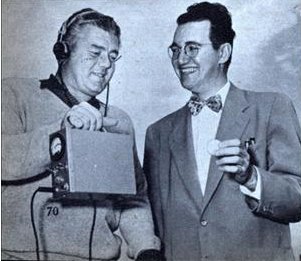
Detectron Model DG-2 measuring atomic golf ball 1950's
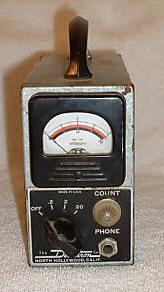
Detectron Model DG-2 early 1950's
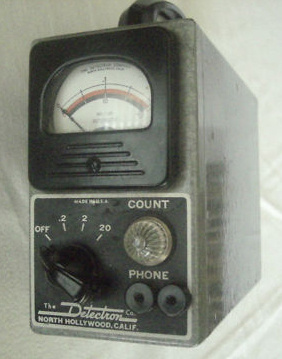
Detectron Model DG-2 early 1950's

Detectron Ad 1950
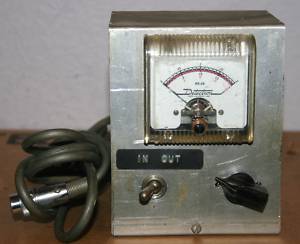
Detectron Model ??
The 1950 version of the Model DG-2 had a square framed meter on the front of the unit with the handle on the top. The unit had a large intensity meter with three sensitivity ranges. The unit was small and weighed 4.5 lbs. A triple check on any radioactive material is possible with the Detectron 3-way "Triple Check" signal system. The headset gives clicks, the count indicator flashes and the intensity if recorded on the meter.
The unit came with a guarantee that read “The DG-2 is guaranteed to be sensitive to all radioactive materials and to be equal in performance to any portable counter on the market regardless of cost”. It had three sensitivity ranges of 0.2, 2 and 20 mR/h. It could use a headset with sharp clicks, the count indicator flashes, and the intensity meter records radiation in mR/h.
It no longer required the three large, heavy 300-volt batteries like the Omaha Scientific Supply Company units but could generate the same voltage through two 45-volt B-batteries. As such, the units were lighter and readily excepted by the amateur prospectors. The unit sold for $98.50 in 1951 and came with an ore sample. The unit came with a belt to strap to the prospector’s waist. The unit was 3” x 6” x 7.5” and weighed 4.5 lbs.

Detectron Model DG-2 1950-53

Popular Science Ad 1950

Detectron Ad 1955
The 1954 version of the Model DG-2 moved the handle from the top of the unit to the side with the meter for easier viewing of the controls and meter.

Detectron Ad 1955

Detectron Model DG-2 Ad 1955

Detectron Model DG-2 1954

Detectron Model DG-2 1950's
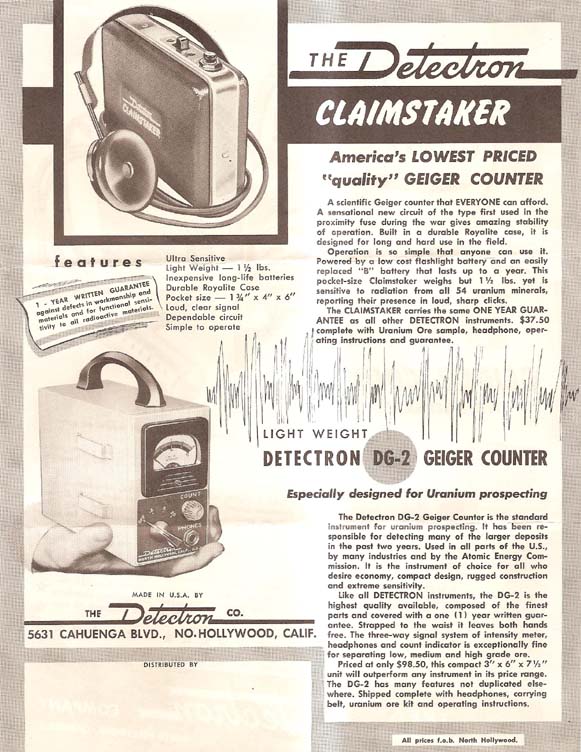
Detectron Model DG-2 Ads 1953

Detectron DG-2 Ad 1955

Detectron DG-2 Ad by Shelden's Mineral Agency 1955
Detectron redesigned the Model DG-2 in 1955 with many new features. The new features include a wide-face, easy-to-read sensitivity meter and a time response switch. The switch can be set to fast for prospecting or slow for sample checking. It operates on 900V using standard low cost batteries. It weighs 5 lbs. The cost was $98.50.

Detectron Model DG-2 Redesigned 1955
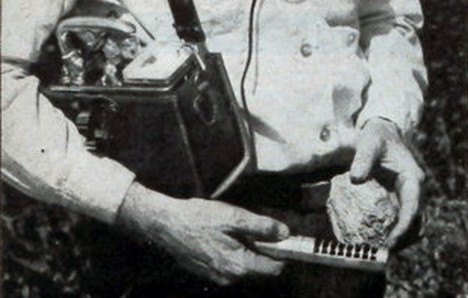
Detector measurement of an ore sample
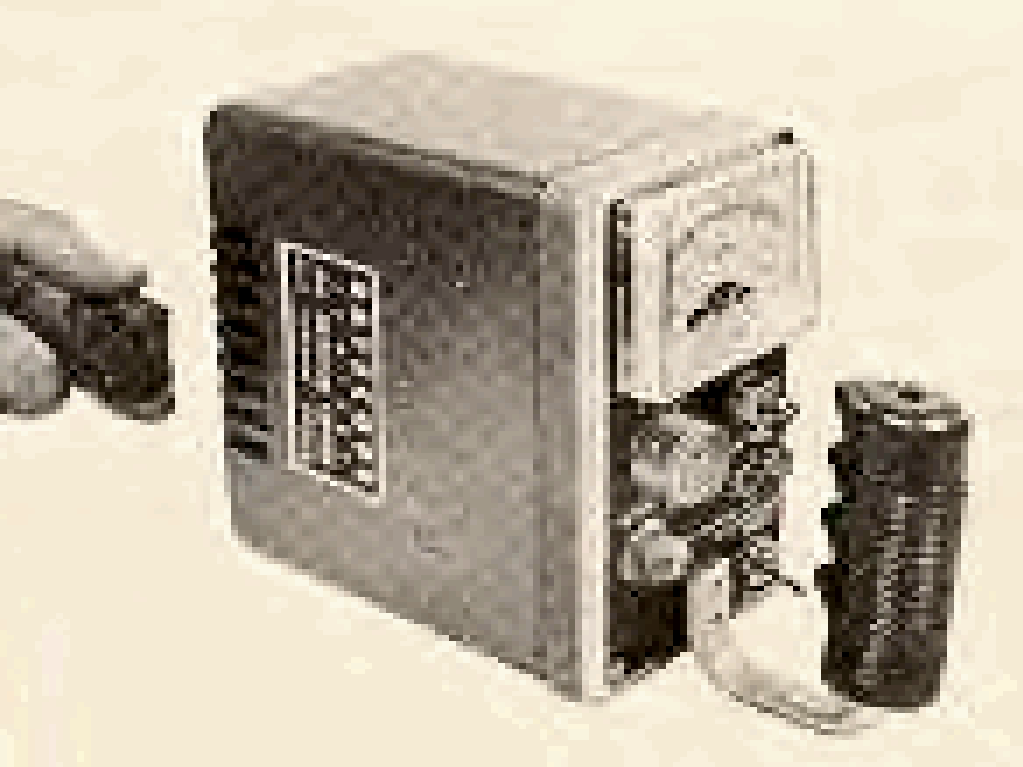
Detectron DG-2 with Sample Checker 1955
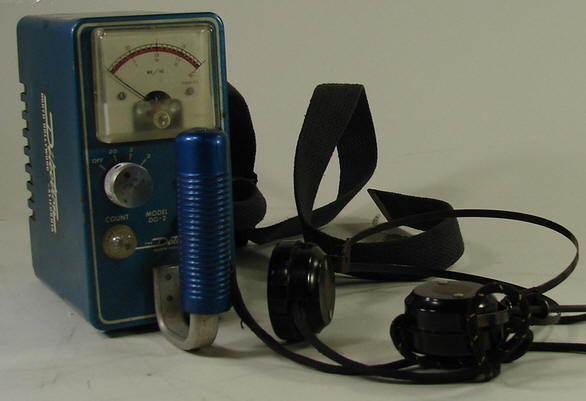
Detectron DG-2
The Model DG-2 was immensely successful, as thousands of amateur prospectors searched for uranium and other elements in
the post World War II era. The Model DG-2B was available with a bismuth tube for extra sensitivity and sold for $127 in 1955. The company sold over 20,000 units in the first few years.The “Claimstaker” Model DG-5 was introduced in 1950. It is built into a plastic Royalite case and has an on-off switch and charging button. The unit is pocket size. It is sensitive to “all 54 uranium minerals”. It uses a loud sharp clicking sound for detection and comes with an ore sample. It was 1-3/4” x 4” x 6”, weighed 1.5 lbs., and was easy to carry in the palm of your hand. The unit was simple to operate and relatively compact. If it discharges below operating voltage, it was simple to reactivate by re-pressing the voltage button. The unit has a thin wall cover for the geiger counter and will detect high-energy betas. There are holes in the bottom of the unit so that nothing will interfere with the sensitivity for gammas or betas. The unit is monitored via headphones that record clicks when a uranium source is detected. It sold for $37.50 in 1950.
One of the key achievements at Detectron was a circuit to give approximately 900 volts from a 45 volt battery. This enabled them to make a much lighter product.

Detectron Claimstaker Model DG-5 1953

Detectron Claimstaker DG-5 1950

Detectron Claimstaker Model DR-5
The Detectron DG-7 was offered in 1953 and is similar to the DG-2 except that it has an external geiger counter probe with a beta shield. It sold for $98.50. The external probe allowed for probing crevices and checking ore samples. There are three range settings with sensitivity from 0.2-20 mR/h. The unit also has a specimen holder. Ore samples would be crushed to a uniform powder, sifted through a screen and pressed level into the sample tray. Accuracy depended on how well you could reproduce the measurement geometry. It was advertised as "tropicalized, fungus-resistant and waterproof". The unit was designed for mineral prospecting or for civil defense decontamination monitoring. A quarter pound commercial grade ore sample should give 1 mR/h on contact. A light on the front panel would illuminate as counts were detected for night use. The unit sold for $135 in 1953. The DG-7B option provided an extra sensitive bismuth tube and sold for $162 in 1955.
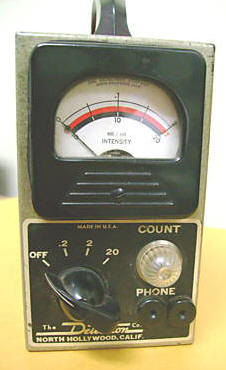
Detectron Model DG-7 1950's
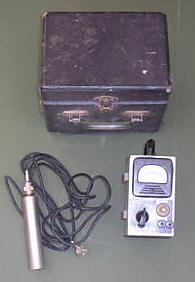
Detectron Model DG-7 1950's

Detectron Model DG-7 Ad 1953

Detectron Model DG-7

Detectron Model DG-7
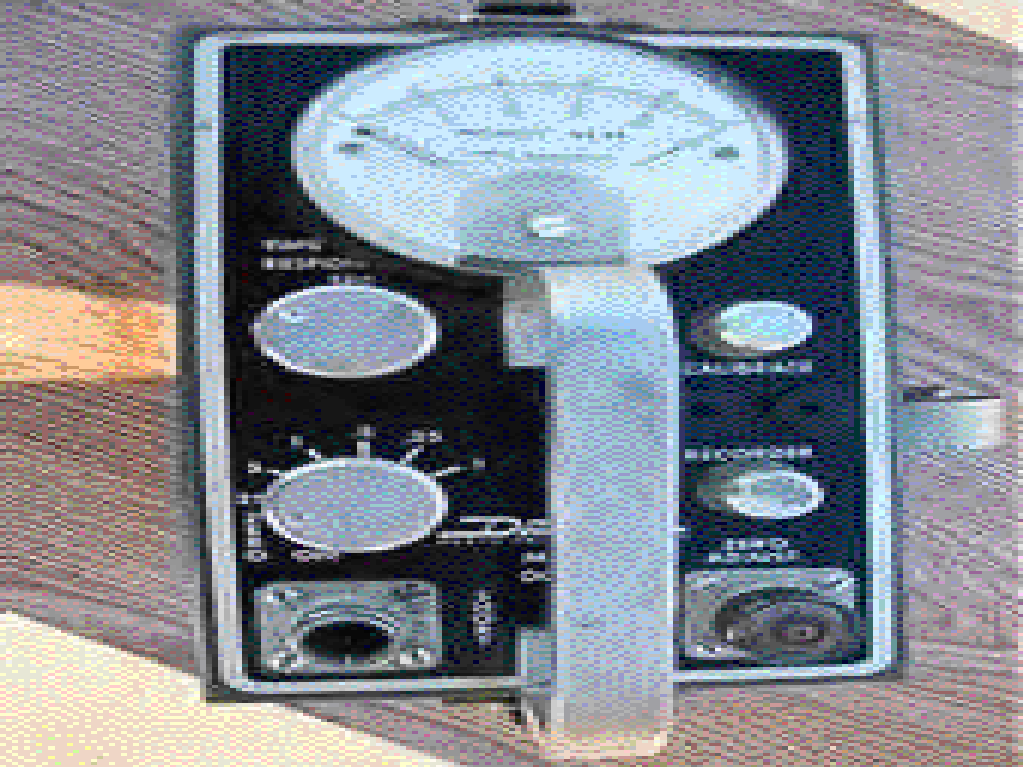
Detectron Model DG-7
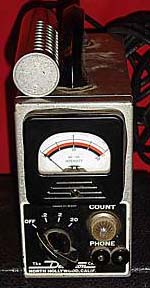
Detectron Model DG-7
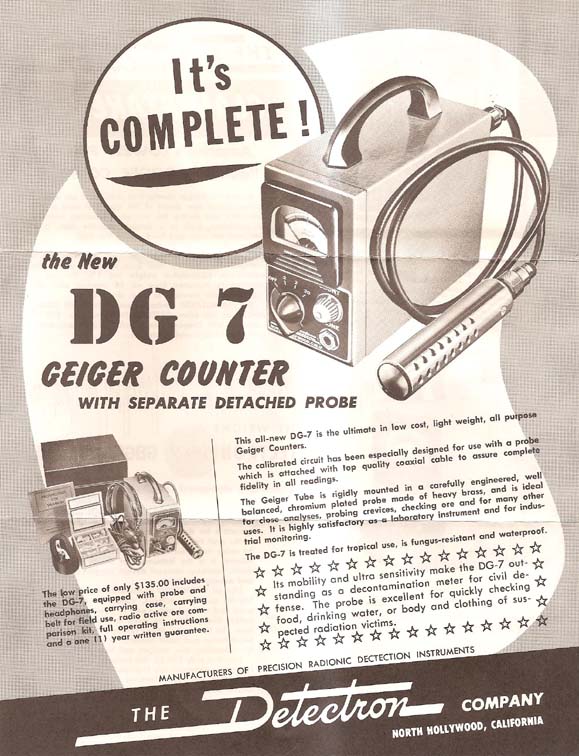
Detectron DG-7 Ad 1953
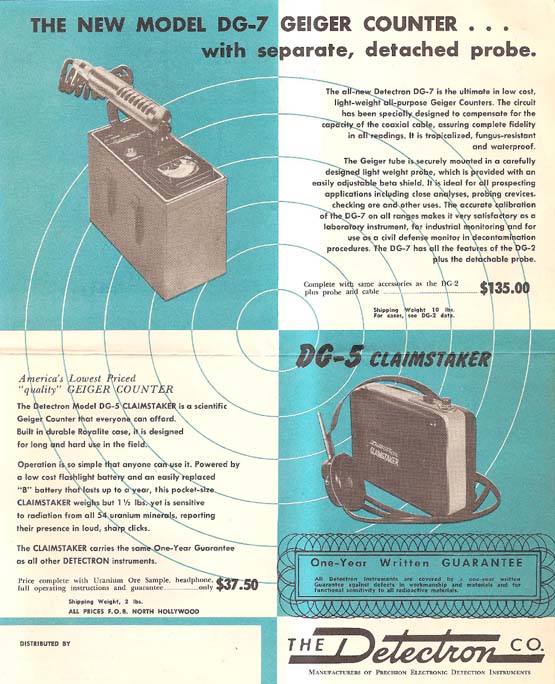
Detectron DG-5 and DG-7 Ad 1950's
In 1955, the DG-7 sold for $135. The 1955 unit offered a probe attachment on the handle as opposed to to the clip on the side of the unit. The unit also has a new square shaped meter.
The following is an another example of a Detectron advertisement. It states “In 1849, all you needed was a pan and some luck in avoiding Indians, but in 1955 you’ve got to choose the best instrument for your purse and purpose”.

Detectron Ad 1955
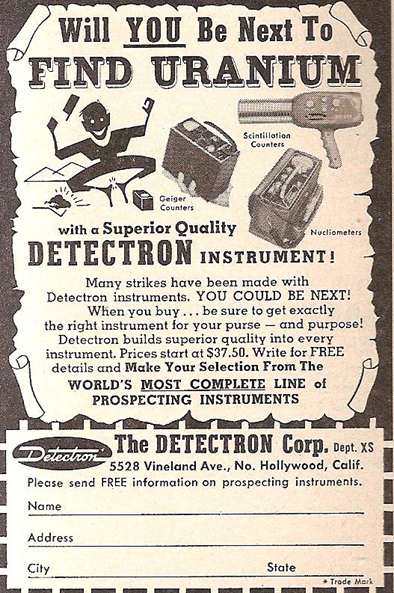
Detectron Ad 1955
The Model DG-9 was a Drill Hole Counter offered in 1955. It was a super-sensitive, lightweight, all purpose geiger counter. The purpose of the drill hole probe was to determine if there was a uranium vein in a drilled hole. The probe was lowered into the hole and the readout indicator monitored. An elevated reading would indicate a possible uranium ore deposit for further investigation. It operated on 900V. It came equipped with the standard DG-7 probe and a 100-foot cable and a drill hole probe that could withstand 20 atmospheres pressure. The probe is specially weighted so it will not float, completely waterproof, and tapered so it will not catch on obstructions. It was advertised for drill hole probing to 1000 feet. The unit is 4.25” x 7.25” x 7” and weighed 10 lbs. The unit sold for $250.

Detectron Model DG-9 Drill Hole Probe 1955

Detectron Model DG-9 Ad 1955
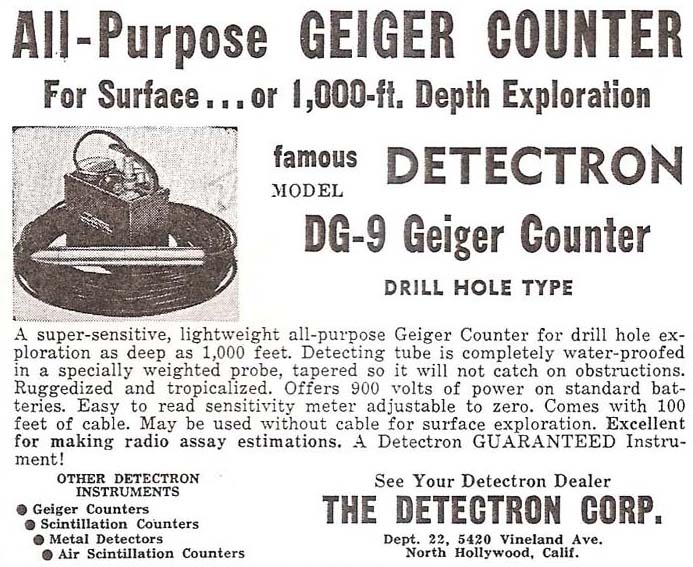
Detectron Model DG-9 Ad 1955
The Model DG-10 was introduced in 1950 as classroom demonstrator for radioactivity measurements. It measured 8” x 8” x 10” and weighed 13 lbs. It had two ranges from 0.2 and 20 mR/h. It had a 5” speaker and operated on AC. It used a self-quenching beta gamma tube in an external probe. It had a meter and neon light for indications.

Detectron Model DG-10 1950
Detectron also produced three models of scintillation counters in 1955 to include the DS-222 Scinatron (1/2” x 1” sodium iodide) for $289, the DS-277 Scintometer (1” x 1” sodium iodide), for $389, and the DS-288 (1” x 1/2” sodium iodide) for $495. With these units, Detectron offered the world’s most complete line of radiation counters. The DS-222 Scinatron was an economy scintillator. It had six ranges of 0.025, 0.05, 0.25, 1, 5 and 25 mR/h. It used one 67.5, two 30 volt and three flashlight batteries. The unit is 4.25” x 7.25” x 7” and weighed 6 lbs. It came with a radium sample for calibration.
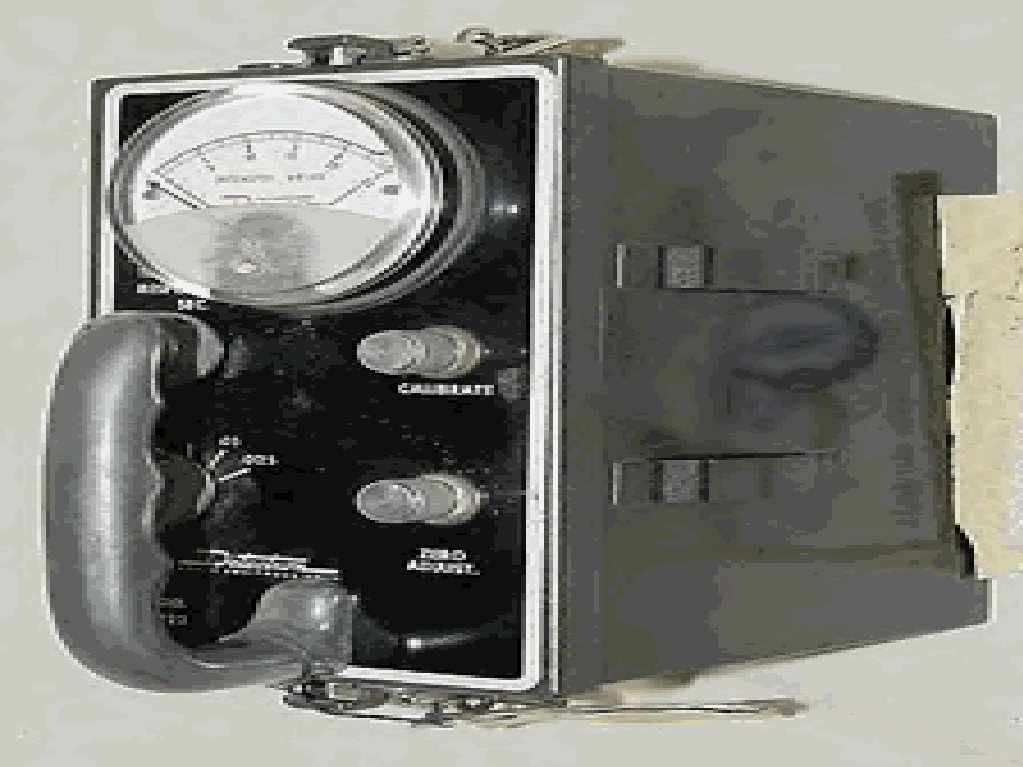
Detectron DS-222 Scinatron 1955
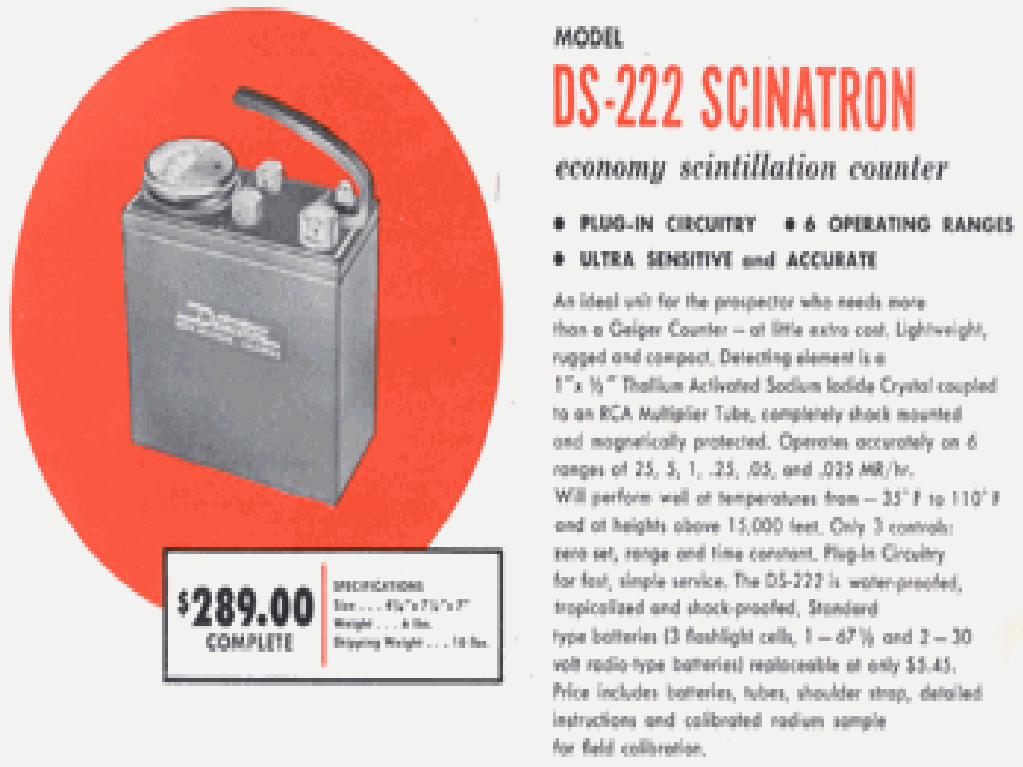
Detectron Model DS-222 Scinatron 1955
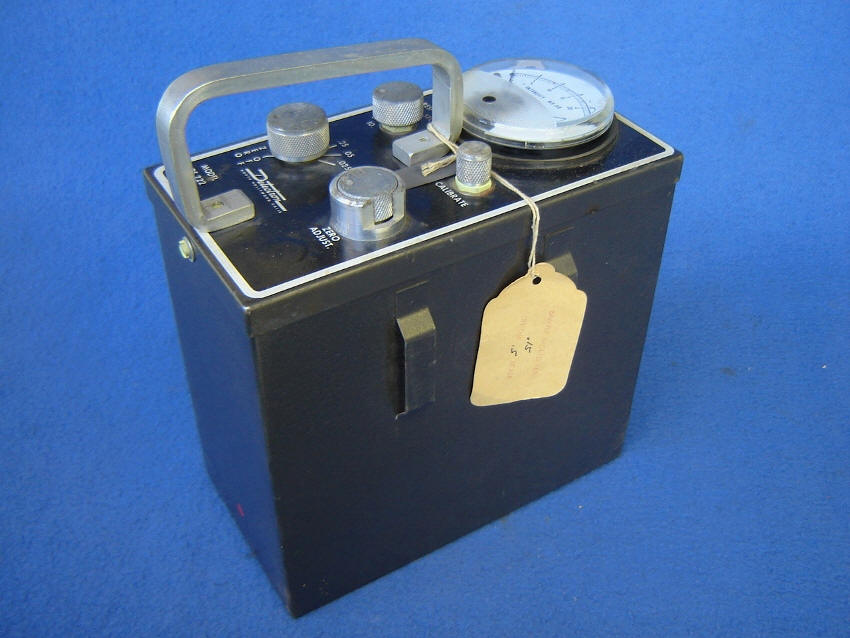
Detectron Model DS-222 Scinatron 1950's
The Detectron Model DS-234 “Sintillatron” (also referred to as DR-234) is a "scintillation counter for uranium prospecting with the latest techniques in this fine instrument in 1955". It consists of a power package with the batteries and electronic power supply. The gun portion contains the photomultiplier, amplifiers, controls and meter. A four-foot cable connects the two parts. The power package is usually strapped to the belt. The manual states that the Atomic Energy Commission (AEC) indicated that 60 mR per day is the maximum amount of dose that is totally harmless. It had six range of 0.025, 0.05, 0.25, 1, 5, and 25 mR/h. It was available in 1954. It had a 1.5" x 1” sodium iodide crystal. The unit uses one 67.5, two 30 and three 1.5-volt batteries. The unit was shiny blue with silver detector housing and a dark gray battery box. The battery box was 3.25” x 5.25” x 5-5/8” and the probe was 2-3/16” x 11.5” and weighed 10 lbs. It sold for $467 in 1955.

Detectron Model DS-234 Scintillatron 1954
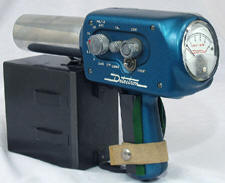
Detectron Model DS-234 Scintillatron 1954
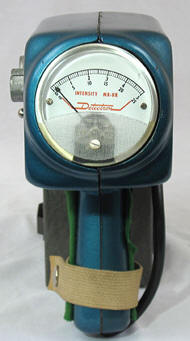
Detectron Model DS-234 Scintillatron 1954
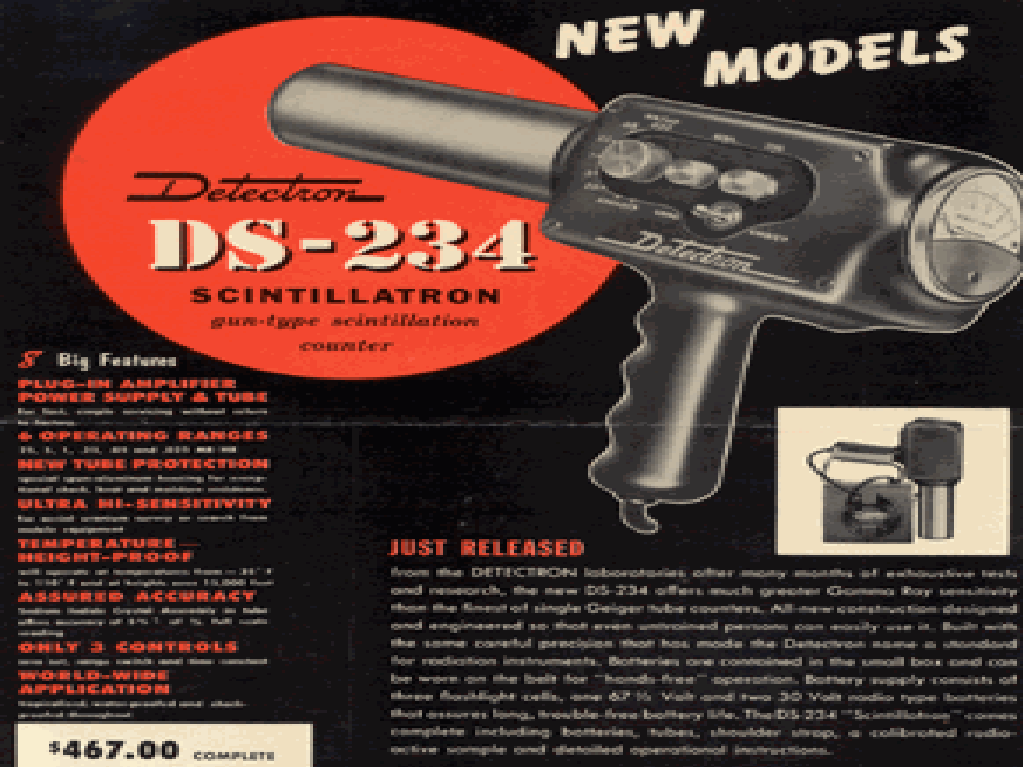
Detectron Model DS-234 1955
The Model DS-235 (also referred to as DR-235) and DS-288 were very similar in many respects. The Model DS-235 Scintillatron was similar to the DS-234 introduced in 1954. It uses a 1.5” x 1” sodium iodide crystal. The full-scale sensitivity is 0.01 mR/h. It has 6 sensitivity ranges and a scale for direct reading in percent ore. The unit was a shiny bronze color with a silver detector housing and dark grey battery box all made of aluminum. The unit used three l.5, two 30 and one 67.5 volt batteries. The unit sold for $515 in 1955.
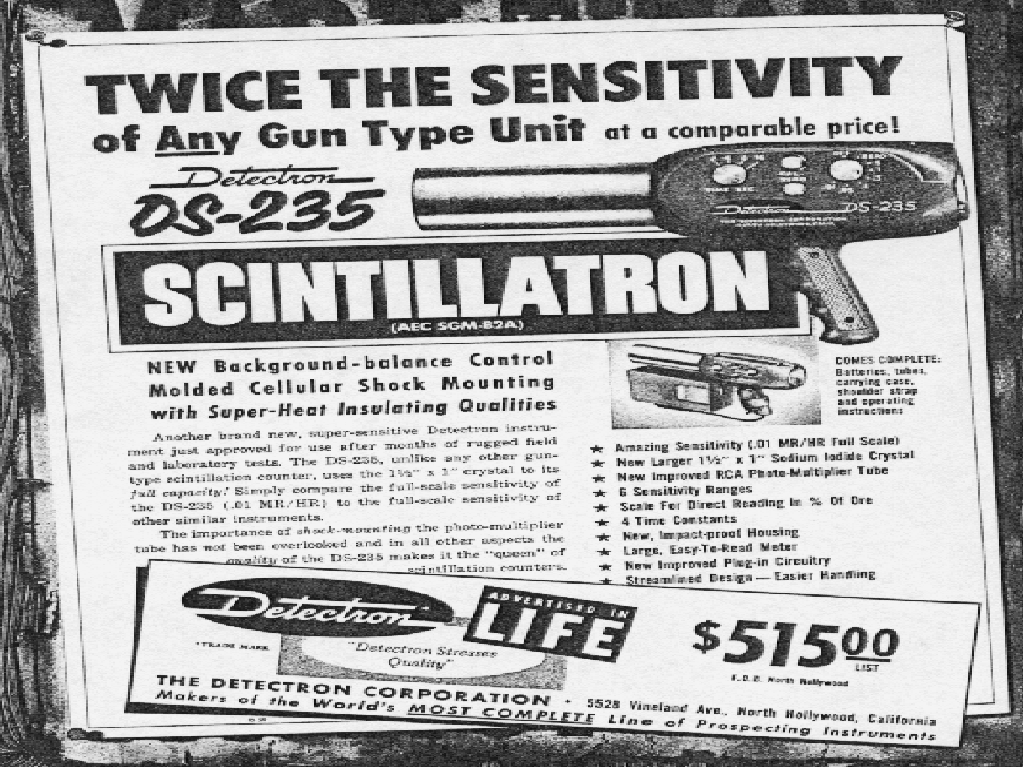
Detectron DS-235 Ad 1955

Detectron Model DS-235 1955
The Model DS-277 Scintometer was offered in 1954. It was a super sensitive instrument for uranium prospecting. It had a 1”x 1” sodium iodide detector. It has six operational ranges from 0.025 to 5 mR/h. It has three controls which include zero set, range, and time constant. It uses 3 flashlight batteries, one 67.5, and two 30-volt batteries. It weighs 6 lbs. and sold for $389.
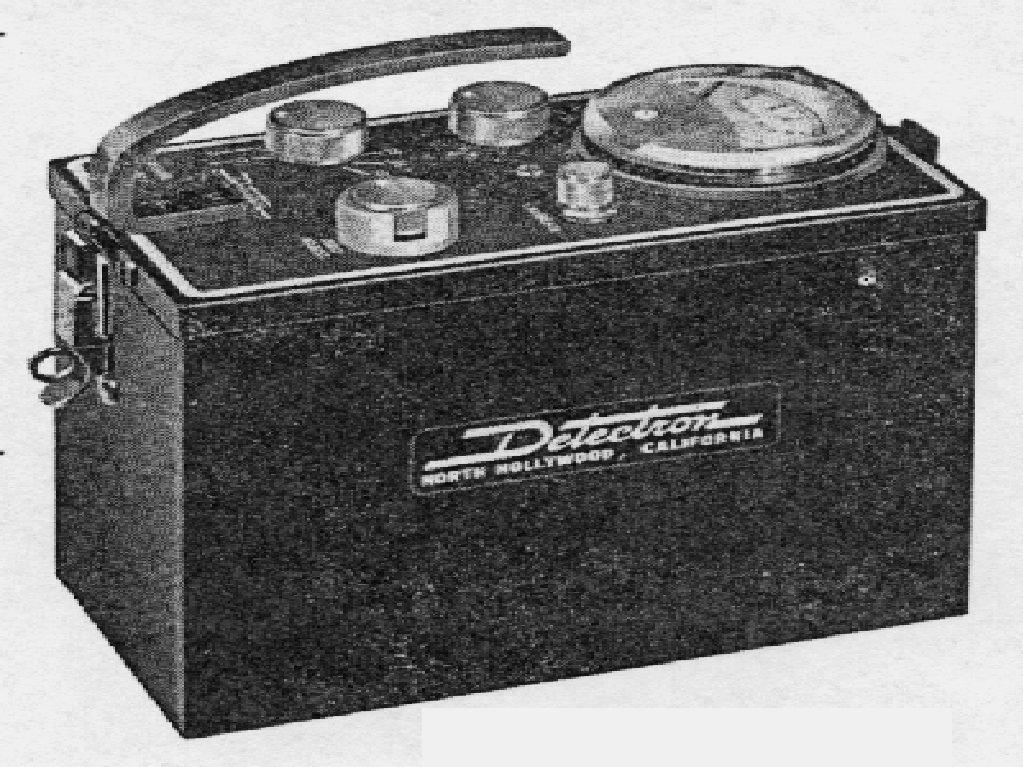
Detectron Model DS-277 Scintometer 1954
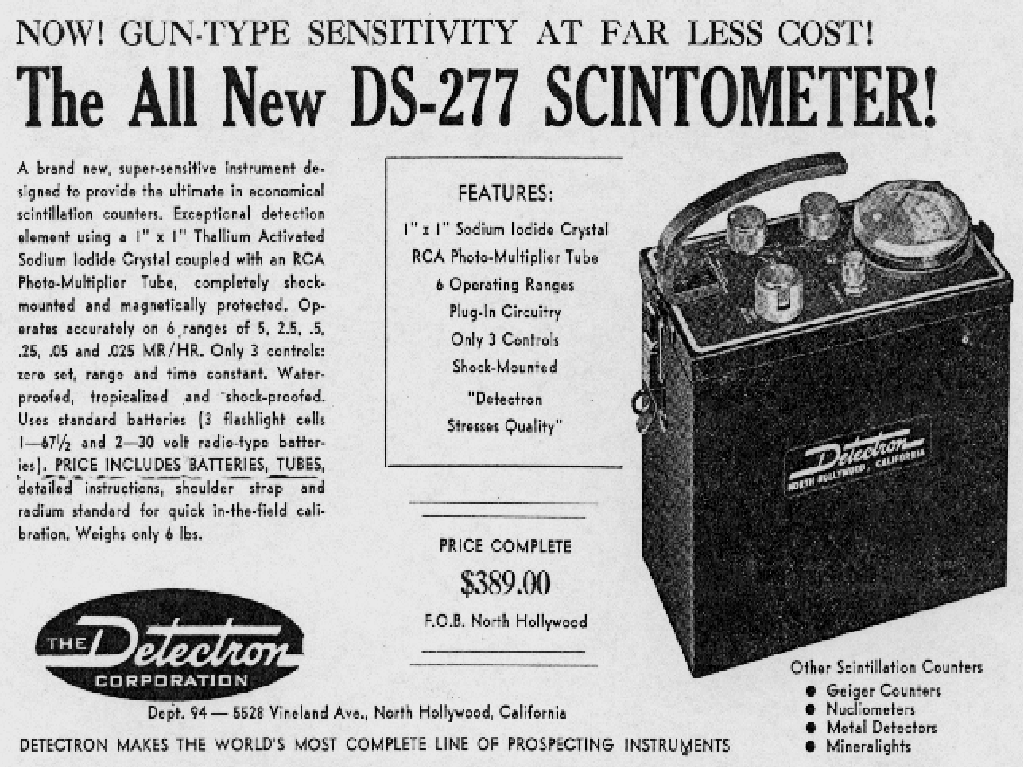
Detectron Model DS-277 Ad 1955
The Detectron Model DS-280 was introduced in 1955.

Detectron Model DS-280 1955
The Model DS-288 Scintillater was offered in 1955. It was advertised as 100% more sensitivity than any other scintillation counter. All components are housed in a single unit. It was "the super sensitive radiation detector of tomorrow". The unit has a 1.5” x 1” sodium iodide crystal. It has sensitivity of 0.01 mR/h. It has six sensitivity ranges and a new wide face, easy-to-read meter. It has 4 time constants. It has a beautiful satin finish box and polished chrome top. The most sensitive spot is marked with a red dot on the front of the outer case. The unit sold for $495.

Detectron Model DS-288 1955
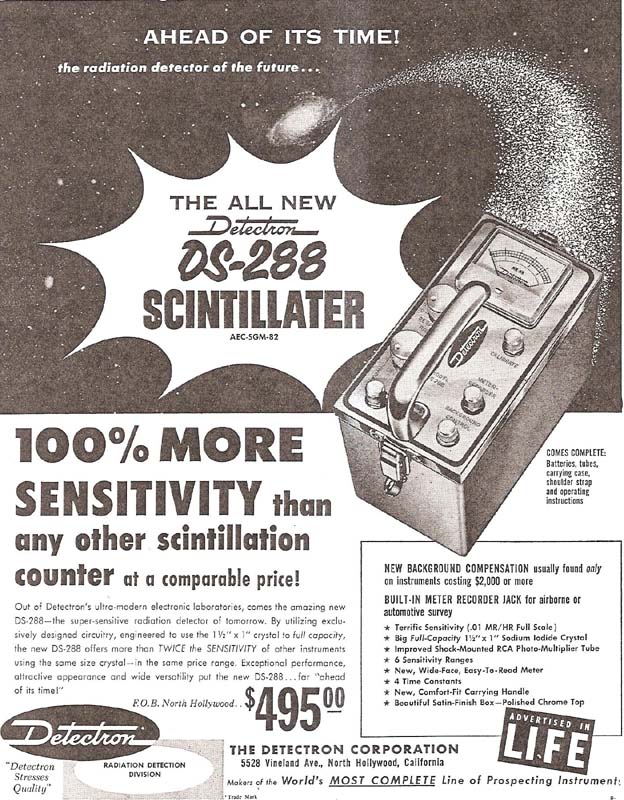
Detectron Model DS-288 Ad 1956

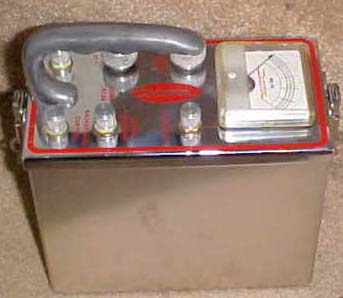
Detectron Model DS-288 1950's
The Nucliometer Model DR-290 was offered in 1954. It was a super-sensitive instrument measuring to 0.02 mR/h. It was designed to recheck areas where less sensitive equipment may have overlooked the deposits. It was unaffected by desert heat. It was available with a detachable meter and cable for airborne use. It was low cost and lightweight. It was also available with the new bismuth tube. It sold for $545.
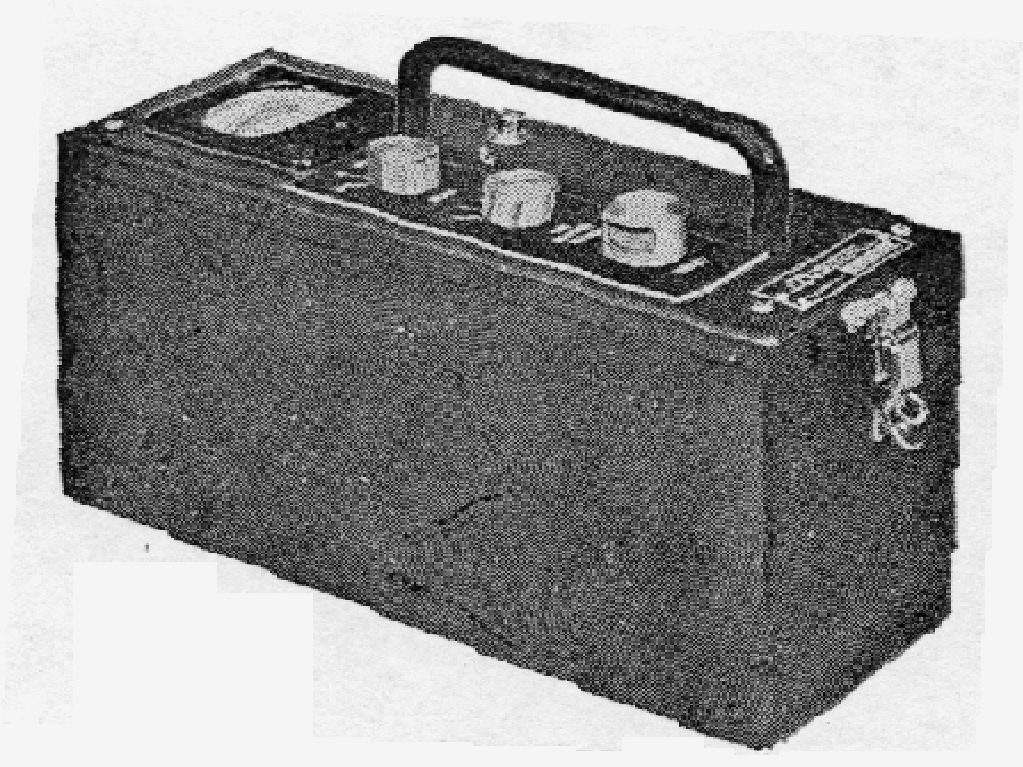
Detectron Model DR-290 1954
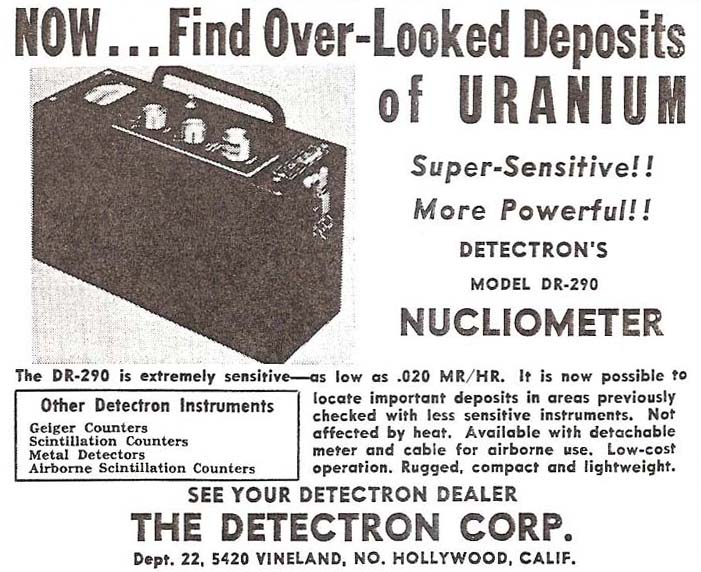
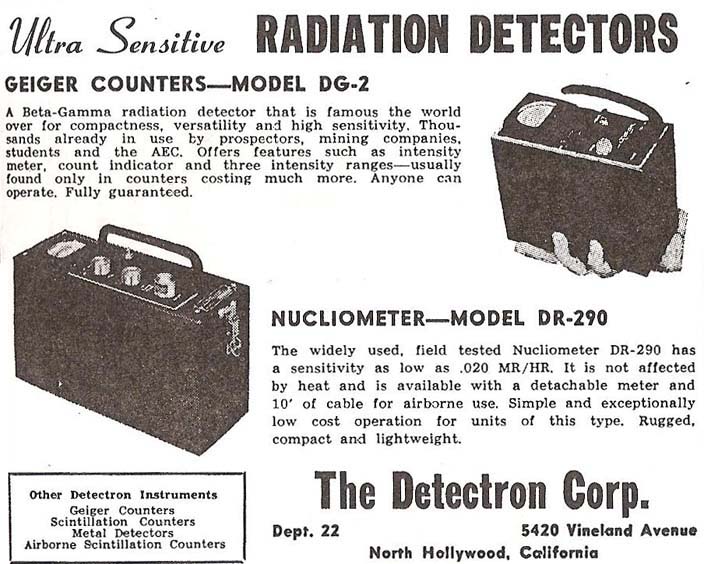
Detectron DR-290 Ad 1955
The Nucliometer Model DR-299 was described as the most versatile uranium detector ever built in 1955. It was advertised as the Greatest Advancement in Uranium Detection in Years. It could detect deep-hidden ore. It weighed 9.5 lbs. One readout option was percent uranium ore and came with a sample holder. It claims to be more sensitive than a 1.5 “ x 1” sodium iodide scintillation crystal. The list price in 1955 was $545 and included the probe, specimen holder, radium calibration source, and leather case. It had 25 Victoreen geiger tubes with a detector area of 42 square inches. The internal scintillation counter is sensitive to 0.01-0.1 mR/h. The external GM probe is sensitive to 0.2-20 mR/h. The Model DR-299-A was designed for airborne use and comes with a 10-foot cable enabling the unit to be placed in the rear aircraft luggage compartment away from the radium dial instruments in the cockpit. The cable was attached to a second meter that could be placed with the cockpit instruments. The unit sold for $545 in 1955.
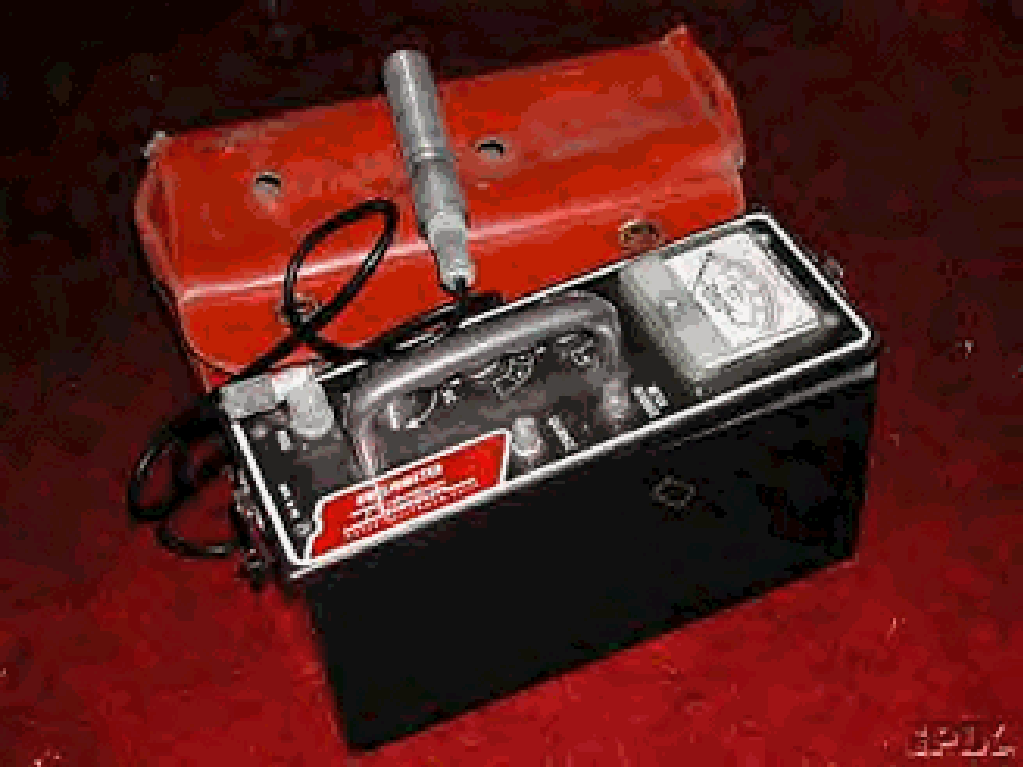
Detectron Model DR-299 1955

Detectron DR-299 Nucliometer 1955

Detectron DR-299 Nucliometer in case 1955
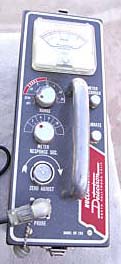
Detectron DR-299 Nucliometer 1950's
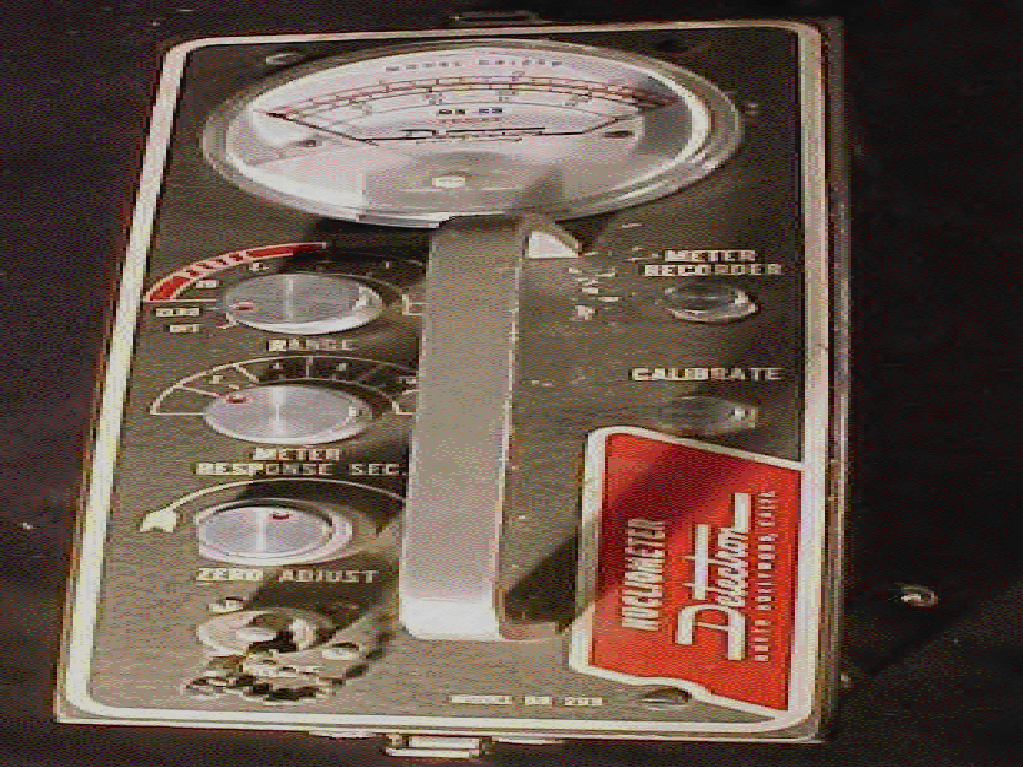
Detectron DR-299 Nucliometer 1956
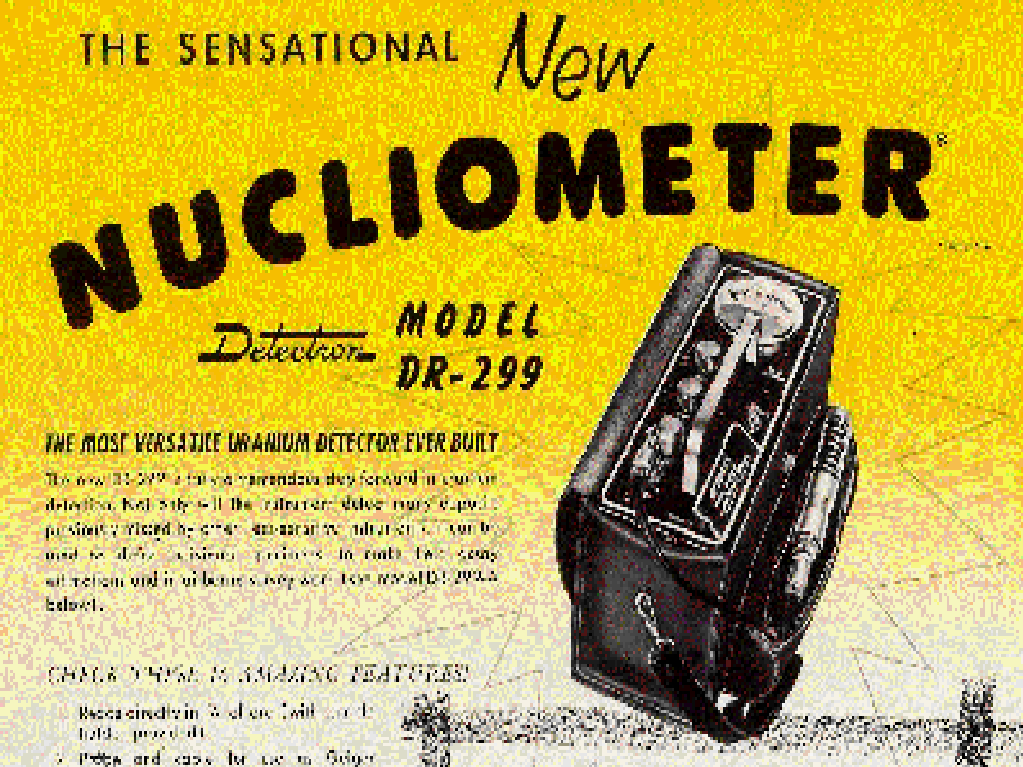
Detectron DR-299 Nucliometer Ad 1955
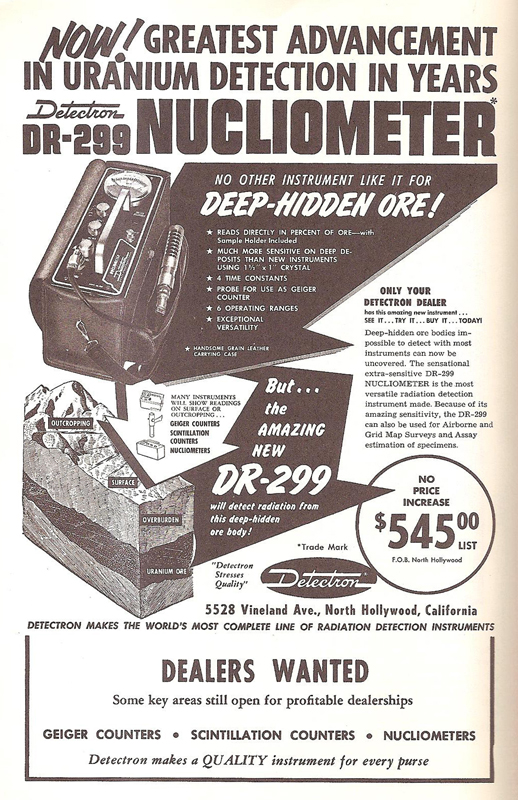
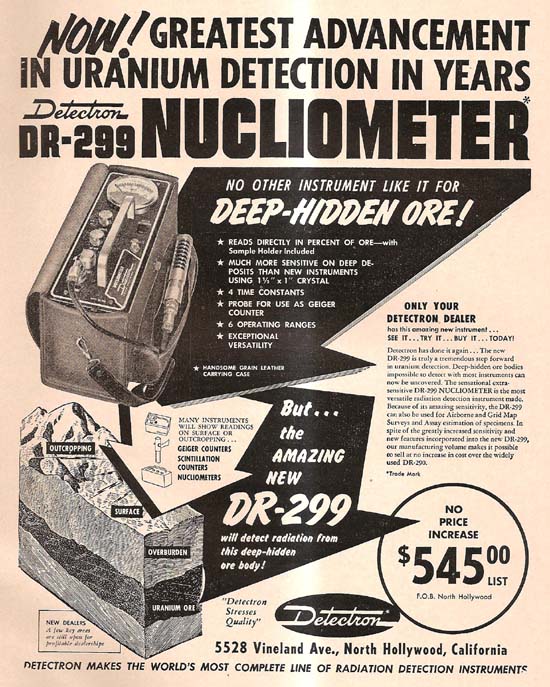
Detectron DR-299 Ads 1955
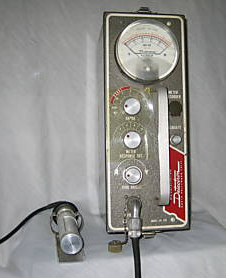
Detectron DR-299 1950's
The Detectron 390-B was described as the “New Bismuth Nucliometer” and was designed to aid in locating mineral deposits. It contained 24 bismuth geiger tubes. The insides of the tubes have a bismuth-coated screen that ionizes the gas more efficiently, thus increasing the sensitivity over normal geiger counters by a factor of 2.5 to 5. This sensitivity increase is useful for weak or distant anomalies. The unit would have sensitivity with 24 tubes from 50-100 times higher than a single geiger tube. Sensitivity was 0.005 mR/h to 0.5 mR/h. It originally sold for $1295 in 1955.
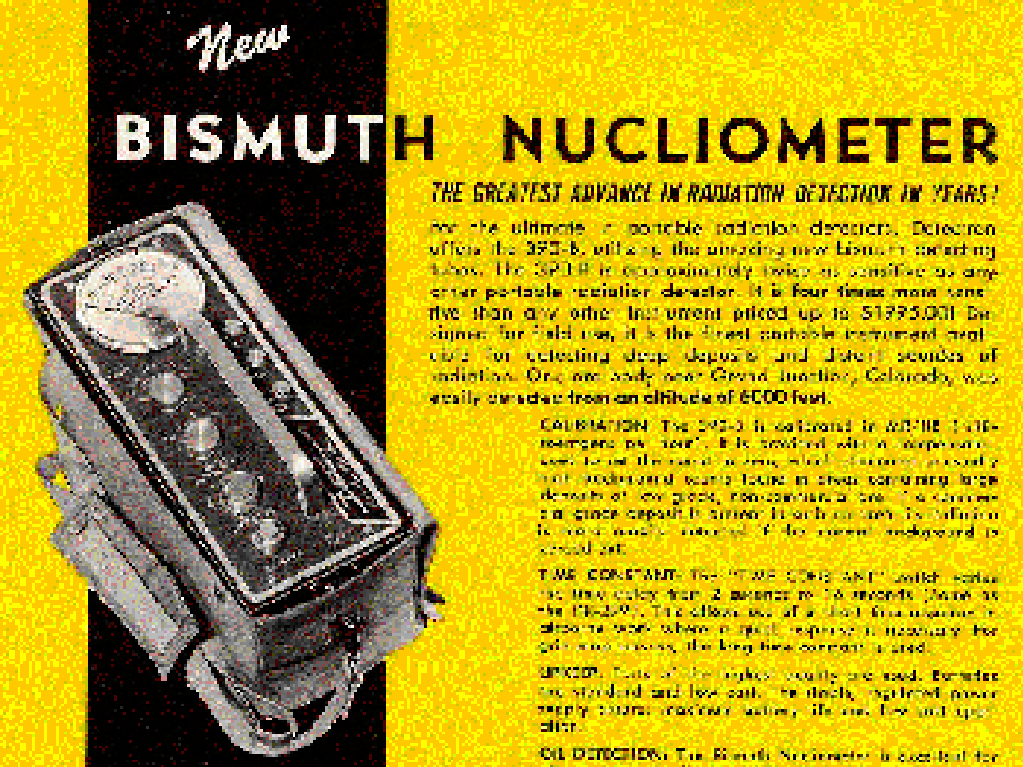
Detectron Bismuth Nucliometer Model 390-B 1954
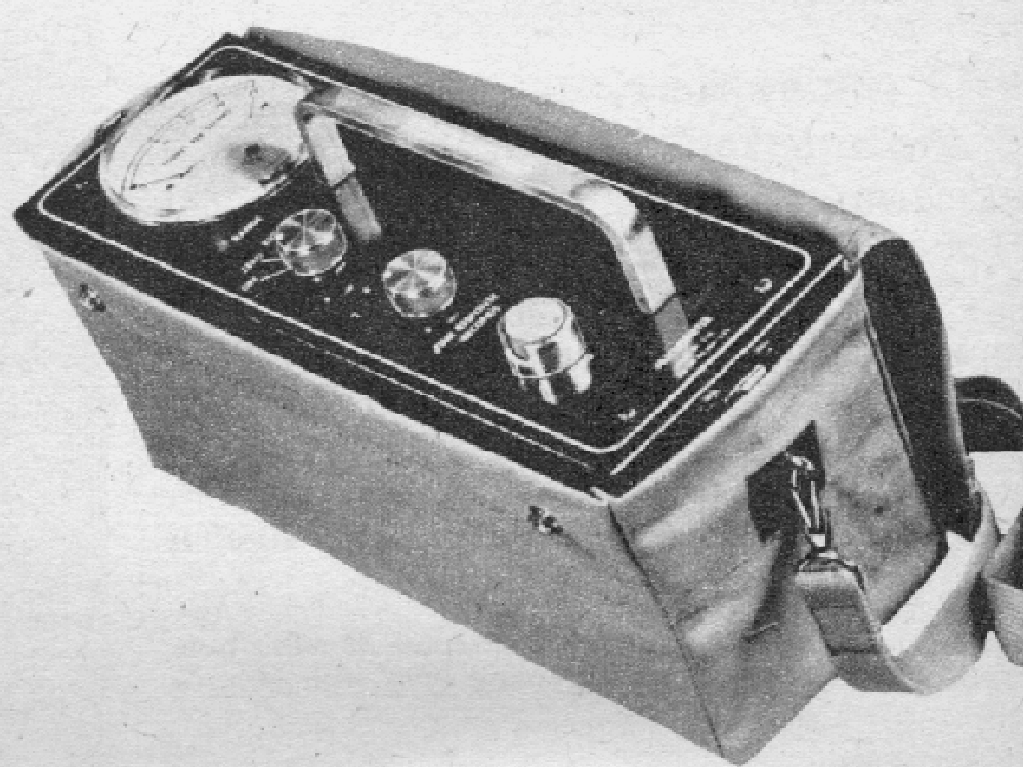
Detectron Bismuth Nucliometer 1955
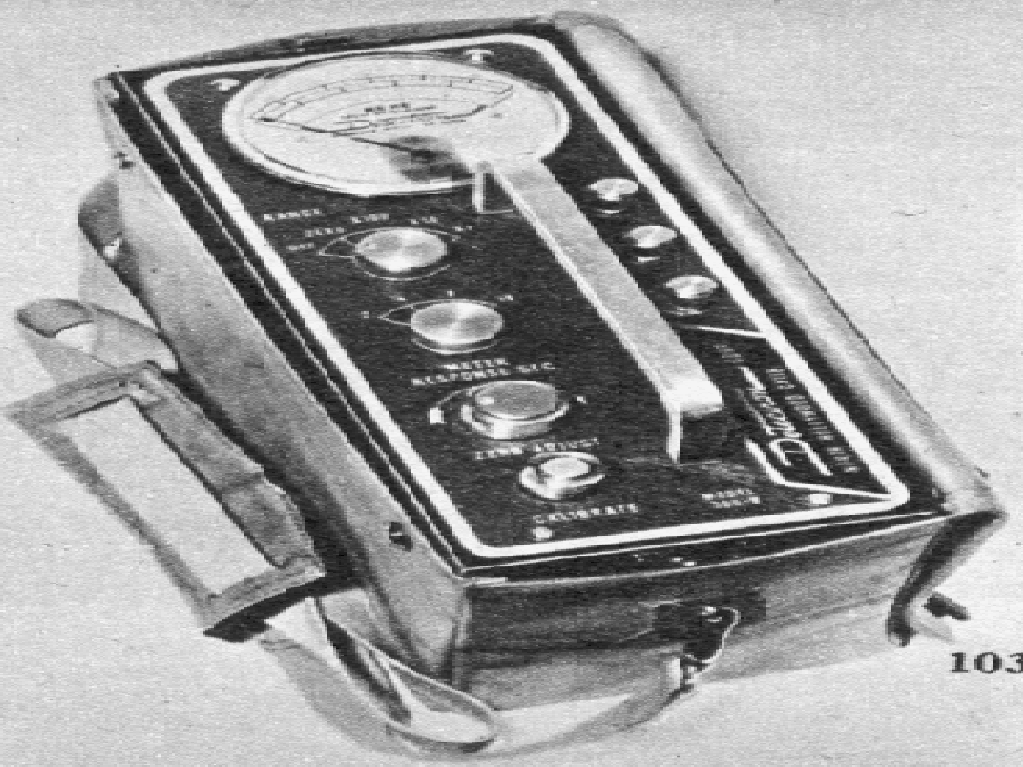
Detectron Bismuth Nucliometer Model 390-B 1955
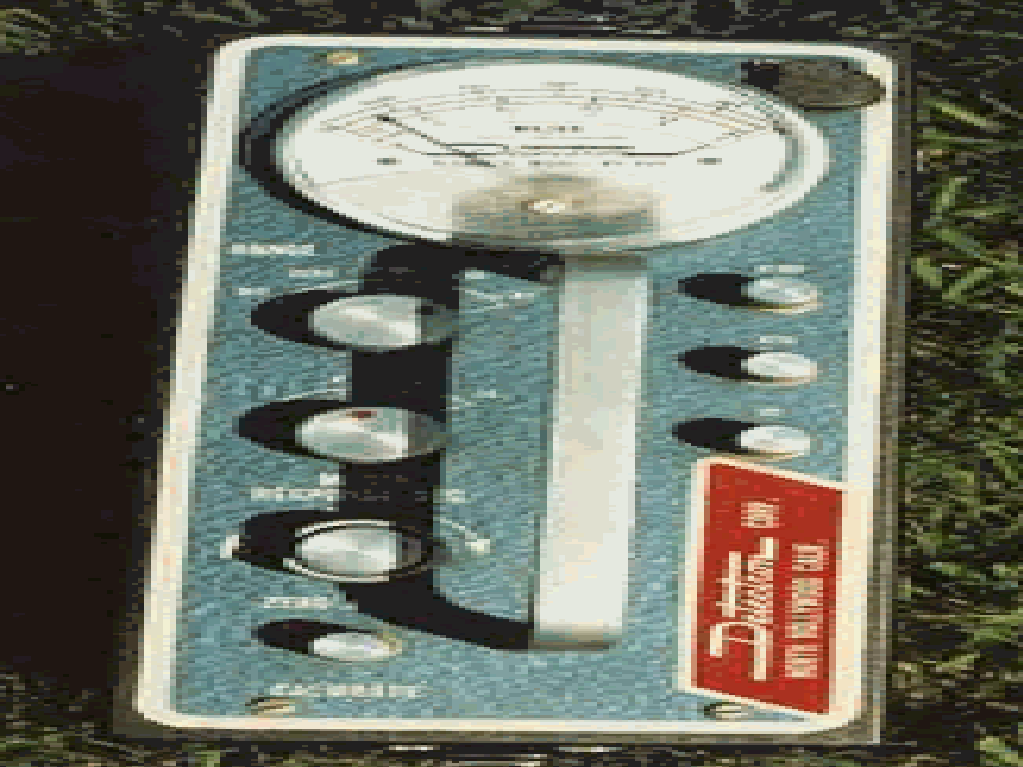
Detectron Bismuth Nucliometer Model 390-B
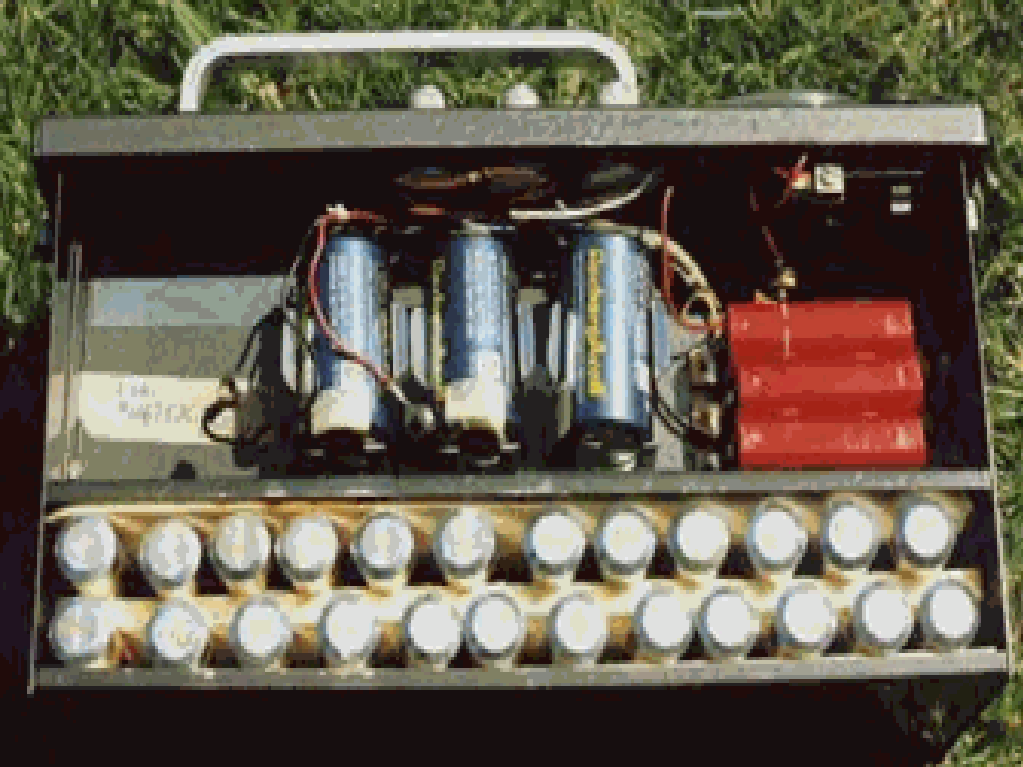
Detectron Nucliometer 390-B Bismuth Tube Array
It was advertised as twice as sensitive as other portable radiation detectors. Claims were that it detected an ore body from an altitude of 6000 feet. An analog display showed mR/h and the background could be zeroed for increased sensitivity. A variable time constant could be set from 2 (for aircraft surveys) to 16 seconds for grid map surveys. It also claimed useful for oil detection since oil acts as an absorber for radiation and thus will give a deflection in the negative direction. For airborne work it was necessary to place the detector as far as possible from the airplane cockpit dials which contained radium. An option included a detachable meter and a 10-foot extension cable.
By 1956, the uranium boom was nearly over. Detectron merged with Computer Measurements Company and continued to make a line of Geiger counters. Cassingham sold the company in 1965 to Tinker and Rasor which still sells Detectron products but no Geiger counters. Cassingham eventually went back in business making Geiger counters and founded the Rayscope Company also in North Hollywood, CA.
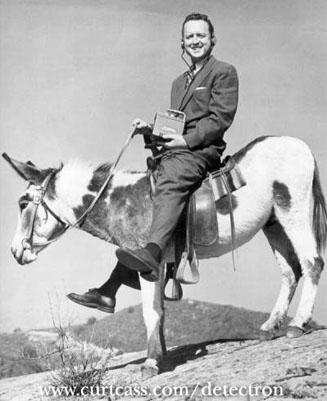
JL "Larry" Cassingham with Detectron meter on donkey 1950's
(image provided with permission of Curt Cassingham, son of Larry Cassingham, via http://www.curtcass.com/detectron, October 25, 2010)
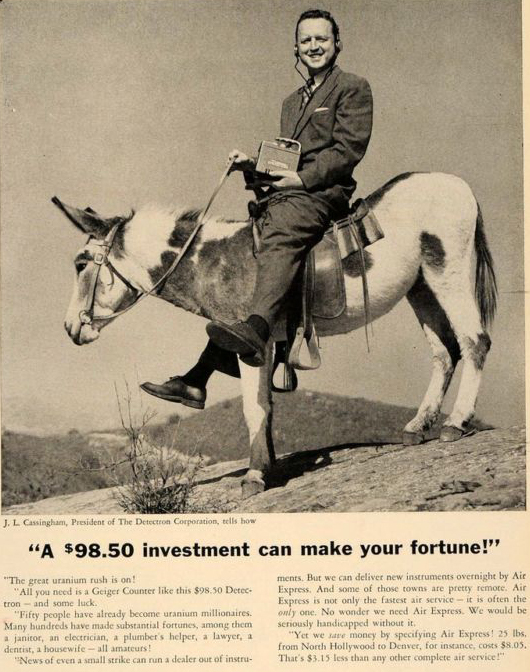
JL "Larry Cassingham" with Detectron meter on donkey 1950's
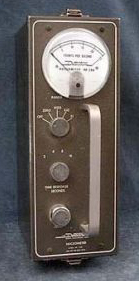
Detectron ?? 1950's
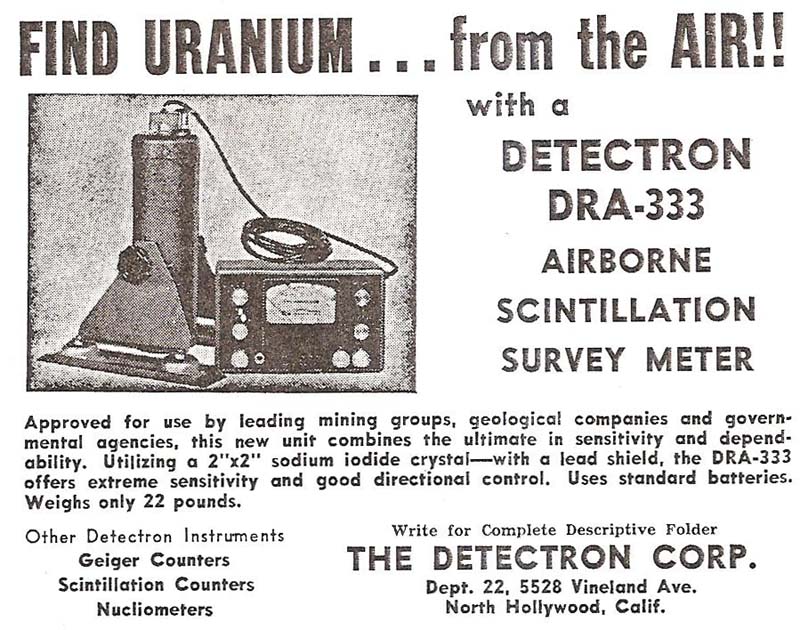
Detectron DRA-333 Airborne Scintillation Meter Ad 1955
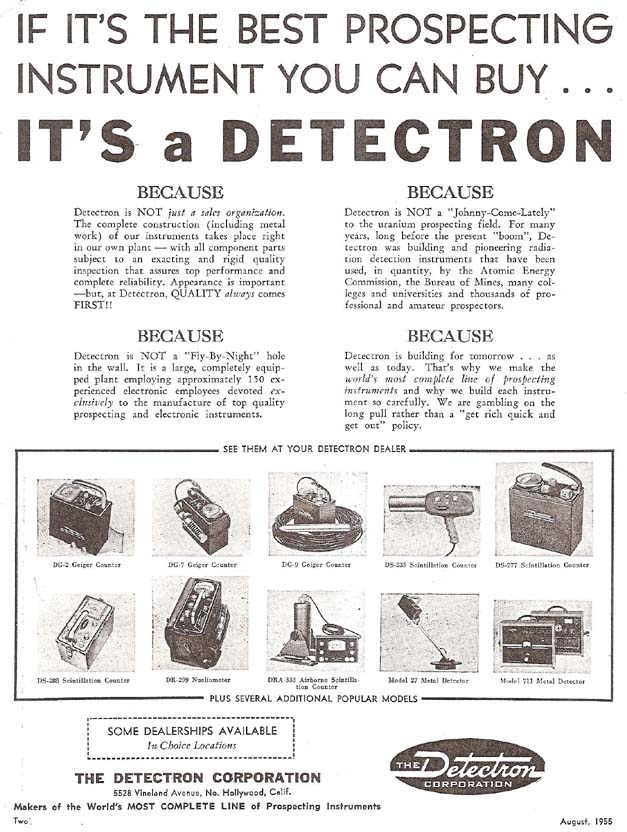
Detectron Ad 1955

Detectron Ad 1956